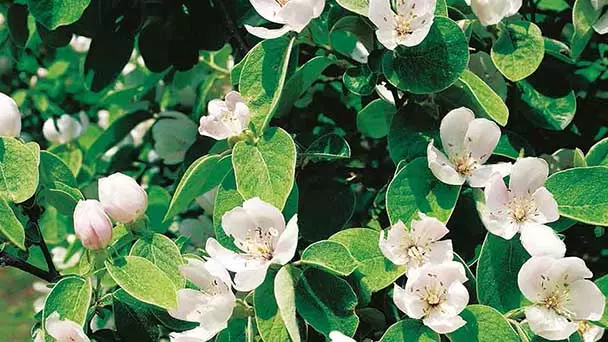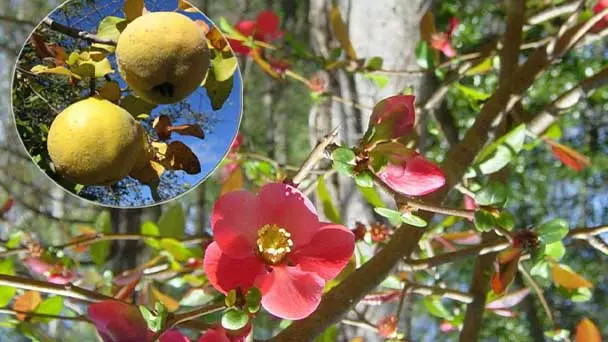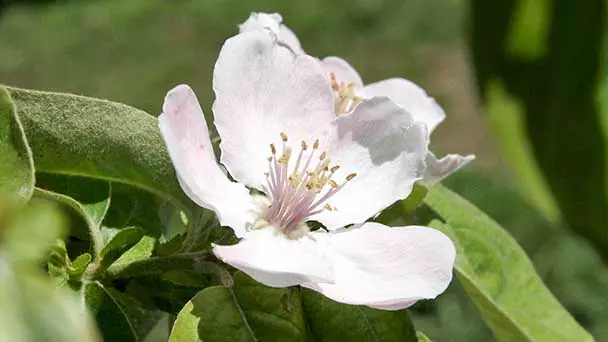Quince Tree Care & Propagation Guide
Written by Ivy
Oct 30 2021

Quince should be very familiar to everyone, and it is also very common in our daily life. Quince tree fruit has very high nutritional value. It has a very good effect of beauty. Quince tree fruit can stew milk, stew soup with other things, or squeeze it into juice. After its fruit is mature, its smell is very fragrant, But the epidermis of quince tree is relatively dry, and its leaves will turn red in autumn.

Quince tree base fertilizer is mostly applied in autumn, and the application amount of base fertilizer accounts for about 70% of the total fertilization amount of the whole year. Topdressing should be carried out in the maximum fertilizer effect period according to the growth and fruit condition of quince tree. In full fruit stage, trees should be timely applied with pre flower fertilizer, post flower fertilizer and fruit expansion fertilizer, and the amount of fertilization for young trees should be reduced. After fertilization, we can irrigate with water once and pay attention to water control during flowering. After planting in arid areas, the tree tray should be covered with plastic film or grass to keep moisture. (Find more healthy fruit here.)
So what does a red flowering quince tree look like? Generally speaking, it is pink or rose red, and some varieties even show a very bright bright red. It's very beautiful, especially beautiful. People can't bear to look away at it. Its color is very gorgeous, and its flowers look delicate and lovely.
Quince tree is a kind of arbor plant, so it can grow very tall and grow to about two meters, which is effortless. If you can raise one at home and keep it well, from March to may, the whole papaya tree is covered with such beautiful flowers, which is very spectacular.
When the pollination process is relatively successful, these flowers will become quinces around September and October. When they are mature, they can be picked and eaten. It can be said that they have both ornamental and edible functions.
Therefore, this quince tree is very popular in many places. It has opened plantations. It can be used as an ornamental plant when flowering, so that a large number of tourists can go for an outing and enjoy it. It can produce a lot of papaya during the autumn harvest, with good economic benefits.
Read Next:
Best Fruits -19 Fruits That Can Improve Your Health
Quince Tree Quick InfoQuince Tree Care in DetailQuince Tree WateringQuince Tree SoilQuince Tree LightQuince Tree TemperatureQuince Tree HumidityQuince Tree FertilizerQuince Tree PruningQuince Tree Pest & Disease ControlQuince Tree PropagationQuince Tree Cutting PropagationQuince Tree Division PropagationQuince Tree Sowing PropagationQuince Tree VarietiesVan DemanOrangePineappleSmyrnaChampionQuince Tree BenefitsQuince Tree Care FAQsWhen does Quince tree blossom?What does red flowering Quince tree look like?
Quince Tree Quick Info
| Botanical/Scientific Name | Cydonia Oblonga |
| Common Name | Quince |
| Varieties | Champion,Orange,Rea's Mammoth,Smyrna |
| Uses | Gastrointestinal aid, skin and hair enhancer, lowering blood pressure |
| Origin | Iran, Turkey, and possibly Greece and the Crimean Peninsula |
| Light Care | Full sun |
| Soil Care | Well-drained |
| Temperature Care | As low as minus 25 degrees Fahrenheit |
| Humidity Care | Slightly moist |
| Watering | Be soaked twice a week |
| Pruning Care | Remove all lower branches |
| Fertilizer Care | Fertilize no more than 2 times each year |
| Propagation | Propagate readily from hardwood cuttings of selected varieties |
| Toxic | Non-toxic to humans and wildlife |
Quince Tree Care in Detail

Quince Tree Watering
Quince tree needs enough water for its growth, but it cannot produce ponding. If there is ponding in the soil for a long time, it will lead to rotten roots. Drainage should be done in time in the rainy season. Autumn is the peak fruit period of quince tree, so it should be watered frequently.Quince Tree Soil
Quince tree does not have strict requirements on soil quality. It grows well in sandy soil with deep soil layer, loose and fertile soil and good drainage. It is not suitable to plant in low-lying ponding.Quince Tree Light
Quince tree is not resistant to shade, so we can choose to avoid the wind and the sun.Quince Tree Temperature
Quince tree likes warm and humid climate and has no strict requirements on soil. It can be planted in warmer places in South China. It is required that the soil be moist and sunny. The most suitable temperature for quince tree is about 22 degrees!Quince Tree Humidity
Quince tree likes half dry and half wet. If the soil is too wet before and after flowering, the flowering period is short. If the soil is dry after fruit, the fruit will be shriveled, and if the soil is too wet during fruit ripening, the fruit will fall.Quince Tree Fertilizer
Fertilization of quince tree is very important. We can combine quince tree fertilization in spring and autumn every year, and carry out two intertillage weeding to loosen the soil, pull out some weeds, and cultivate soil when loosening the soil in winter. In this way, it is conducive to quince tree's antifreeze in winter. Before flowering in spring, top dressing shall be carried out. First, a ring ditch shall be opened around the tree. We can apply fertilizer between each quince tree. In this way, it is conducive to the growth and development of papaya and promote its flowering and fruit bearing.Quince tree base fertilizer is mostly applied in autumn, and the application amount of base fertilizer accounts for about 70% of the total fertilization amount of the whole year. Topdressing should be carried out in the maximum fertilizer effect period according to the growth and fruit condition of quince tree. In full fruit stage, trees should be timely applied with pre flower fertilizer, post flower fertilizer and fruit expansion fertilizer, and the amount of fertilization for young trees should be reduced. After fertilization, we can irrigate with water once and pay attention to water control during flowering. After planting in arid areas, the tree tray should be covered with plastic film or grass to keep moisture. (Find more healthy fruit here.)
Quince Tree Pruning
The natural tree shape of quince tree is in the shape of a broom. Quince tree pruning should be carried out every year for adult trees. Some sick branches, old branches, aging branches and some dense young branches should be cut off. The whole crown of quince tree should be ventilated and transparent, This is conducive to quince tree flowering and fruit bearing.Quince Tree Pest & Disease Control
The common diseases of quince tree include leaf spot disease and ring rot disease, as well as pests and aphids. In the early stage of the disease, it is necessary to spray some chemicals in time, conduct ventilation and light transmission in time, and destroy some diseased fruits, diseased leaves and some residual branches on the ground in time.Quince Tree Propagation

Quince Tree Cutting Propagation
Quince tree cutting propagation is generally from February to March every year. When there is no germination, we can cut some relatively strong and tender branches to cut small segments of 15 to 20 cm, and insert them obliquely in the seedbed according to the distance between each plant. After quince tree cutting, we should cover the field with plastic film shed, Let's keep warm and moisturize. When the soil is dry, we should often water it to keep the field moist. If the weather is cold, we should cover some straw curtains and other items for thermal insulation. When the weather is sunny, we should uncover the film for ventilation. When the weather is gradually warm during the next spring, we can plant roots and sprouts, and then dismantle the shed in the middle and late April to strengthen management, We should carry out intercropping and weeding in time and topdressing in time. After one year of cultivation, quince tree can be planted when it grows to 70 to 80 cm high.Quince Tree Division Propagation
Quince tree division propagation can be used. Quince tree has strong ramet ability and can grow a lot of young plants from the root every year. Before March, dig out the young plants growing around the old quince tree together with this root. Plant the smaller ones first, cultivate them for one to two years, and then plant them. This method will make quince tree bloom and bear fruits earlier. The method is also relatively simple, and the survival rate is relatively high.Quince Tree Sowing Propagation
We can also carry out quince tree sowing propagation. Quince tree seeds are sown in autumn and spring. Autumn sowing is in the late October of each year. When papaya seeds are mature, the fruits are picked and the seeds in papaya are taken out, In November, we can open holes according to the distance between each plant of 15 cm to 20 cm. The height of the hole is 6 cm. Two or more seeds are sown in each hole, and then the soil is covered. In spring, the seeds of quince tree are sown in the first and last ten days of March, and then we put them in water, soak two seeds, and then fish them out, Put it in the basin, cover it with some wet cloth, put it in a warm place for 24 hours, and then sow. The sowing in autumn can come out in the spring of the next year. The sowing in spring comes out from the late April to the early May of each year. When the quince tree grows to about one meter, it can be planted.Quince Tree Varieties
Van Deman
These quince tree varieties is a kind of papaya variety in early autumn. The peel is orange and the pulp is a little granular. "Vanderman" needs more refrigeration time than "orange"Orange
These quince tree variations are named after their flesh color, not their appearance. Another early autumn variety "orange" also has a strong taste, large size and yellow skin.Pineapple
As the name suggests, these quince tree variations have a taste of tropical fruit. Yellow skinned papaya varieties have a white appearance. Pineapple is a low-temperature fruit that matures in the middle of autumn.Smyrna
The yellow skin of these quince tree variations is covered with light brown fluff. "Smyrna" is famous for its soft interior and large size. Papaya in mid autumn is one of the low temperature varieties.Champion
These quince tree varieties are also a kind of papaya in mid autumn, which requires more refrigeration time than "pineapple" or "Smyrna". From the shape, the pulp of "champion" is light green, much like a big pear.Quince Tree Benefits
Quince tree can be used for garden construction, community greening, tourist scenic spots, grasslands, etc. it can be planted into a sea of flowers in groups, or a single tree can be planted into a single landscape. Quince tree can also be matched with rockery landscape, and the scene is particularly good. Quince tree can also be arranged into papaya slope, papaya garden, papaya River, papaya Road, etc. Garden application papaya is a very useful variety in the greening of the park. It can enjoy flowers and leaves. The branches of quince tree are also tall and straight.Quince Tree Care FAQs
When does Quince tree blossom?
Quince tree blooms around April in spring. The flowers are light pink, the petals are obovate, and the pedicels are short and thick. Quince tree is cultivated for a long time. Generally, after planting, it needs to be maintained for 3 ~ 4 years to blossom and bear fruit. However, when cultivating and maintaining quince tree, we should pay attention to good methods. If the method is incorrect, it may not blossom normally. We should give sufficient light and appropriate fertilizer and water to ensure smooth flowering.What does red flowering Quince tree look like?
Just before it grew papaya, the red flowering of quince tree occupied the whole papaya tree, which was particularly spectacular and beautiful.So what does a red flowering quince tree look like? Generally speaking, it is pink or rose red, and some varieties even show a very bright bright red. It's very beautiful, especially beautiful. People can't bear to look away at it. Its color is very gorgeous, and its flowers look delicate and lovely.
Quince tree is a kind of arbor plant, so it can grow very tall and grow to about two meters, which is effortless. If you can raise one at home and keep it well, from March to may, the whole papaya tree is covered with such beautiful flowers, which is very spectacular.
When the pollination process is relatively successful, these flowers will become quinces around September and October. When they are mature, they can be picked and eaten. It can be said that they have both ornamental and edible functions.
Therefore, this quince tree is very popular in many places. It has opened plantations. It can be used as an ornamental plant when flowering, so that a large number of tourists can go for an outing and enjoy it. It can produce a lot of papaya during the autumn harvest, with good economic benefits.
Read Next:
Best Fruits -19 Fruits That Can Improve Your Health
Latest Updated
- Benefits of Bugleweed - 7 Science-backed Health Benefits
- Bugleweed Dangers & Side Effects - Is It Poisonous?
- How to Plant Evergreen Trees - What You Should Know
- When to Plant Evergreens - Grow Guide for Evergreen Trees
- 12 Wonderful Evergreen Shrubs for Your Garden
- 12 Popular Evergreen Plants with Pictures for Beginners
- When And How To Prune A Lilac Bush Like a Pro
- How to Grow & Care for Lilac Vine (Hardenbergia Violacea)
- Japanese Lilac Tree (Syringa Reticulata) Care & Propagation Guide
- Shumard Oak Pros and Cons - What to Know
Popular Articles
- Winter maintenance of Antirrhinum Majus
- How to Grow Terminalia Mantaly Tree
- How to Grow and Care for Crossostephium Chinense
- How to grow Antirrhinum Majus in spring
- Peristeria Elata (Dove Orchid) Profile: Info & Care Guide
- Underwatered Snake Plant (Sansevieria Trifasciata) - Signs And How To Fix
- How to Care for Brazilian Jasmine Plant (Mandevilla Sanderi)
- How to Grow & Care for Graptopetalum Purple Delight in Summer
- Rosa Chinensis (China Rose): Plant Growing & Care Tips
- How to Care for Baby Sun Rose (Aptenia Cordifolia)